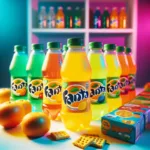How To Know If Food Contains E Numbers?
Confessional insights for anyone curious, concerned, or confused about E numbers in food—and how to spot them before you eat.
Why You Need to Know About E Numbers
Have you ever stood in a grocery aisle, squinting at a label, wondering what those mysterious “E numbers” mean? I have. It started after a friend’s allergic reaction to a snack—something we thought was safe. That moment changed how I look at packaged foods forever. If you’re reading this, you probably want to know how to know if food contains E numbers? and what it means for your health, family, and peace of mind.
E numbers are codes for food additives approved by the European Food Safety Authority (EFSA) and recognized in many countries. They can be preservatives, colorings, flavor enhancers, or stabilizers. Some are harmless, others controversial. According to the EFSA, these additives help keep food fresh and appealing, but not everyone reacts the same way (PubMed).
What Are E Numbers? A Quick Table
| E Number | Additive Type | Common Example | Potential Concern |
|---|---|---|---|
| E100–E199 | Colors | Curcumin (E100) | Rare allergies |
| E200–E299 | Preservatives | Sorbic acid (E200) | Asthma risk |
| E300–E399 | Antioxidants | Ascorbic acid (E300) | Generally safe |
| E400–E499 | Thickeners, Stabilizers | Alginic acid (E400) | Digestive upset |
| E500–E599 | Acidity regulators | Sodium carbonate (E500) | Rare reactions |
How To Spot E Numbers On Food Labels
It sounds easy, but labels can be tricky. In the US, the FDA requires food additives to be listed by their chemical names, not E numbers (FDA Food Labeling Guide). In the EU, E numbers are often listed directly—sometimes alongside the additive’s name.
- US Labels: Look for names like “Sodium Benzoate” instead of “E211”.
- EU Labels: You’ll see “E211 (Sodium Benzoate)” or just “E211”.
- Other Countries: Australia and Canada may use a mix of names and codes.
Tip: If you’re traveling, check local food labeling laws. The FoodNavigator recently compared EU and US laws, highlighting how easy it is to miss E numbers if you’re not careful.
Why Do E Numbers Matter For Your Health?
Some E numbers are linked to allergies, asthma, or hyperactivity—especially in children (PubMed Study). Others are considered safe by authorities. The EFSA regularly reviews additives for safety, while the FDA maintains a list of approved substances.
- Preservatives (E200–E299): May trigger asthma or skin reactions.
- Colors (E100–E199): Some artificial colors are controversial.
- Sweeteners (E950–E969): Linked to digestive issues in sensitive individuals.
According to a recent New York Times article, the EU has banned or restricted several additives still allowed in the US, making label reading even more important for travelers and expats.
Q&A: How To Know If Food Contains E Numbers?
- Q: What’s the fastest way to check for E numbers?
- A: Scan the ingredients list for codes starting with “E” followed by three digits (e.g., E330). If you’re in the US, look for chemical names and cross-reference with an E number chart.
- Q: Are E numbers always bad?
- A: No. Many E numbers are safe and naturally derived. Some, however, may cause reactions in sensitive people. Check with your doctor or use a scanner app if you’re unsure.
- Q: Can Food Scan Genius help?
- A: Absolutely. The Food Scan Genius app lets you scan barcodes or ingredient lists to instantly flag E numbers, allergens, and additives. It’s a game-changer for anyone with dietary restrictions or health concerns.
Food Scan Genius: Your Pocket Ingredient Detective
When I first started checking for E numbers, I spent hours googling codes and chemical names. Then I found Food Scan Genius. With a quick scan, I get instant alerts about E numbers, allergens, and even vegan status. Here’s how it works:
- Scan any packaged food’s barcode or ingredient list
- See flagged E numbers, with health risk info
- Customize for allergies, vegan/vegetarian, or other preferences
- Get updates on new regulations and banned additives
“I have a child with food sensitivities. Food Scan Genius has saved us from accidental reactions and endless label reading. Highly recommend!” — Jessica, Berlin
Download Food Scan Genius to make label reading effortless, wherever you shop.
Global Perspective: US vs. EU Labeling Laws
Understanding E numbers is even more important if you travel or buy imported foods. Here’s how regulations differ:
| Region | Labeling Authority | How E Numbers Are Listed | Key Differences |
|---|---|---|---|
| United States | FDA | Chemical names only | Some additives allowed in US are banned in EU |
| European Union | EFSA | E numbers plus additive name | Stricter bans and regular safety reviews |
| Australia/Canada | FSANZ/CFIA | Mix of codes and names | Similar to EU, but less strict on some additives |
News Update: The BBC reports ongoing debates about food additive bans in Europe, while US authorities continue to review some controversial substances.
Tips For Safer Shopping: What I’ve Learned
- Always read the label, especially when buying new or imported foods.
- Use a scanner app like Food Scan Genius for instant answers.
- Check for updates—regulations change, and what’s safe today may be banned tomorrow.
- Know your sensitivities and consult your doctor about risky additives.
- Traveling? Research local labeling laws before you shop.
FAQ: E Numbers In Food
A: Some E numbers may trigger allergies, asthma, or hyperactivity, especially in sensitive individuals. Most are considered safe by regulatory authorities, but always check labels and consult your doctor if unsure.
A: Choose whole, unprocessed foods, and use scanner apps to check packaged products. In the EU, look for codes starting with “E”; in the US, check chemical names.
A: Yes, Food Scan Genius offers a free version with essential features. Premium upgrades are available for advanced scanning and personalized alerts.





